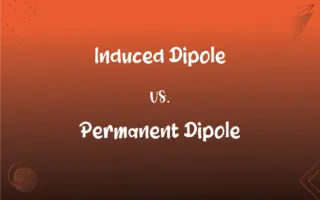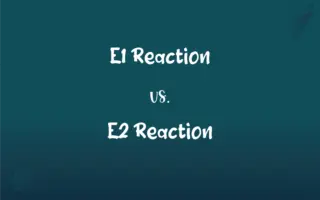AAS vs. AES: What's the Difference?
Edited by Aimie Carlson || By Janet White || Published on March 2, 2024
AAS (Atomic Absorption Spectroscopy) is a technique for analyzing metal concentrations, while AES (Atomic Emission Spectroscopy) involves measuring the light emitted by atoms to determine element composition.

Key Differences
Atomic Absorption Spectroscopy (AAS) and Atomic Emission Spectroscopy (AES) are both analytical techniques used in chemistry and physics to analyze the elemental composition of a sample, but they operate on different principles and are used for different purposes. AAS measures the absorption of light by atoms vaporized in a flame or graphite furnace, which is directly proportional to the concentration of the element in the sample.
AAS is renowned for its sensitivity and specificity for trace metal analysis, often requiring minimal sample preparation, AES is valued for its broad applicability and the ability to analyze multiple elements at once, making it a versatile tool in both research and industrial applications. However, AAS generally has lower detection limits for most elements, making it the preferred choice for trace analysis where high sensitivity is required.
In practical applications, the choice between AAS and AES often depends on the specific requirements of the analysis, including the elements of interest, the concentration levels expected, and the matrix of the sample. AAS is frequently used in environmental, biological, and food analyses for trace metals detection, whereas AES is widely used in metallurgy, geochemistry, and industrial quality control for its ability to rapidly assess multiple elements.
Both AAS and AES require sophisticated instruments that are capable of producing accurate and reliable results. These instruments, however, differ in their design, operational procedures, and the way the data is interpreted. AAS instruments are typically simpler and less expensive than those used for AES, but AES instruments offer the flexibility of conducting more comprehensive analyses.
Comparison Chart
Principle
Measures absorption of light by atoms
Measures emission of light by atoms
ADVERTISEMENT
Sensitivity
High sensitivity for trace metal analysis
Broad applicability for multiple elements
Sample Preparation
Minimal for liquid samples
Varies, often more complex for solids
Analytical Application
Ideal for trace metals in environmental samples
Suitable for broad elemental analysis
Instrumentation
Generally simpler and less expensive
More complex and capable of multi-element analysis
AAS and AES Definitions
AAS
Technique for metal concentration analysis.
AAS is used to detect lead in drinking water.
ADVERTISEMENT
AES
Supports simultaneous multi-element analysis.
AES simultaneously detects calcium and magnesium in milk.
AAS
Utilizes light absorption.
In AAS, mercury vapor absorbs ultraviolet light.
AES
Based on light emission.
In AES, sodium ions emit yellow light when excited.
AAS
Requires atomization.
AAS involves converting liquid samples into a gas.
AES
Can analyze solid and liquid samples.
AES is used to assess the purity of gold jewelry.
AAS
Sensitive to trace elements.
AAS can measure trace amounts of copper in soil.
AES
Method for element composition analysis.
AES identifies metals in an alloy.
AAS
Employs a monochromatic light source.
AAS uses a specific lamp for each element.
AES
Involves excitation of atoms.
AES uses a plasma to excite atoms in a sample.
AAS
An associate degree conferred for successful studies in applied science.
AES
(rare) a, the name of the letter A.
AAS
A loose sleeveless outer garment made from aba cloth; worn by Arabs.
AAS
An associate degree in applied science
FAQs
How does AAS work?
AAS vaporizes the sample and measures the absorption of light by atoms.
What is AES?
AES is a method for determining element composition based on light emission.
How does AES work?
AES excites atoms and measures the light they emit upon returning to a lower energy state.
What samples can AES analyze?
AES can analyze both solid and liquid samples.
Is AAS or AES more sensitive?
AAS is generally more sensitive, especially for trace metal detection.
Does AES require complex sample preparation?
Sample preparation for AES can vary, being more complex for solid samples.
What is AAS?
AAS is a technique for analyzing metal concentrations by measuring light absorption.
What samples can AAS analyze?
AAS is typically used for liquid samples.
What type of light source does AAS use?
AAS uses a specific monochromatic light source for each element analyzed.
What is the main use of AAS?
AAS is primarily used for trace metal analysis in environmental and biological samples.
What is the main use of AES?
AES is used for broad elemental analysis in various fields, including metallurgy and geochemistry.
Can AES analyze multiple elements simultaneously?
Yes, AES can simultaneously analyze multiple elements.
What energy sources can excite atoms in AES?
Atoms in AES can be excited by thermal or electrical energy sources.
How do analysts choose between AAS and AES?
The choice depends on the analysis requirements, including sensitivity and the elements of interest.
Can AAS detect pollutants in water?
Yes, AAS is commonly used to detect trace metals in water.
Is sample preparation for AAS extensive?
No, AAS often requires minimal sample preparation, especially for liquids.
Are AAS instruments expensive?
AAS instruments are generally simpler and less expensive than AES instruments.
Can AAS measure non-metal elements?
AAS is primarily focused on metal elements.
Is AES used in industry?
Yes, AES is widely used in industrial quality control and material analysis.
What makes AES versatile?
The ability of AES to analyze multiple elements at once makes it versatile.
About Author
Written by
Janet WhiteJanet White has been an esteemed writer and blogger for Difference Wiki. Holding a Master's degree in Science and Medical Journalism from the prestigious Boston University, she has consistently demonstrated her expertise and passion for her field. When she's not immersed in her work, Janet relishes her time exercising, delving into a good book, and cherishing moments with friends and family.
Edited by
Aimie CarlsonAimie Carlson, holding a master's degree in English literature, is a fervent English language enthusiast. She lends her writing talents to Difference Wiki, a prominent website that specializes in comparisons, offering readers insightful analyses that both captivate and inform.







































































